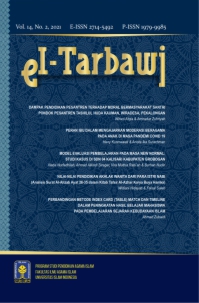Main Article Content
Abstract
This paper intends to discuss how the morals of the Prophet's wives, which
are summarized in Surah Al-Ahzab verses 28-35, used as directions,
references, and instructions for women. The wives of the Prophet are the
mothers of religious people so that it should be used as an example by
Muslims, especially for women. In analyzing Surat Al-Ahzab verses 28-35,
the writer uses the library research approach, with the primary data source
is Buya Hamka's book of Tafsir Al-Azhar. and for the secondary data, the
writer uses various books and journals that are relevant with the topic. This
paper concluded that according to Buya Hamka interpretation, the morals
ordered by Allah SWT to women in Surat Al-Ahzab verses 28-35, is to
choose the afterlife over the temporary world or implementing simple life,
not to commit heinous acts towards others, such as condemning, cursing at
people, stealing, slandering, because it can drop a woman's honor, speaking
well, politely, firmly, not weak and flirtatious, staying at home, not overly
made up and dressed up, worshiping (reading the Koran, giving charity,
Fasting, Dhikr) with khusyu, and clear from all the qualities that defile the
heart (envy, arrogance, envy, and greed).
Keyword: Morality, Tafsir, Character Education, Buya Hamka
Keywords
Article Details
Copyright (c) 2022 Widiani Hidayati, Faisal Saleh

This work is licensed under a Creative Commons Attribution-ShareAlike 4.0 International License.
Authors retain copyright and grant the journal right of first publication with the work simultaneously licensed under a Creative Commons Attribution (CC-BY-SA) 4.0 License that allows others to share the work with an acknowledgment of the work’s authorship and initial publication in this journal.
References
- Al-Ghamidi, Dziyab. (2011). Zikir Sesudah Shalat.Jakarta :
- Republika Penerbit
- Al-Taliyadi, Abdullah. (2008). Astagfirullah Aurat. Yogyakarta:
- DIVA Press
- Gusmian, Islah. (2003). Khazanah Tafsir Indonesia : Dari
- Hermeneutika hingga Ideologi. Bandung : Teraju.
- Hamka, (2015). Tafsir Al-Azhar. VIII. Jakarta : Gema Insani
- Hamka, (2014). Tafsir Al-Azhar.Jilid 1 Juz 1-11. Jakarta: Pustaka
- Panjimas
- Kenang-kenangan Hidup. Jakarta: Bulan Bintang
- Hidayat,Usep Taufik. (2020). “Tafsir Al-Azhar: Menyelami
- Kedalaman Tasawuf Hamka” Buletin Al-Turas, Vol.21,
- No.1.
- Jambak, dan Fabian Fadhly. (2018). “Filsafat Sejarah Hamka:
- Refleksi Islam dalam Perjalanan Sejarah” Jurnal
- THEOLOGIA,Vol. 28, No. 2
- Jameel, Ahmad dan Syaiful Bahri. (2013). Great Moments.
- Bandung: Sygma Creative Media Core
- James R. Rush. (2017). Adicerita Hamka: Visi Islam sang Penulis
- Besar untuk Indonesia Modern. Jakarta: Gramedia Pustaka
- Utama.
- Mega Sari, Lia (2018). “Khusyuk Dalam Al-Qur’an (Kajian
- Tematik).” Jurnal Nun. Vol.4, No. 2
- Muhaimin Seknun, Muslih. (2018). “ Ekspolaitasi Wanita di Era
- Kontemporer (Studi Analisa Tafsir Tabarruj Dalam Al-
- Qur’an).” UIN SyariF Hidayatullah.
- Nizar,Samsul. (2008). Memperbincangkan Dinamika Intelektual dan
- Pemikiran Hamka tentang Pendidikan Islam. Jakrta: Kencana
- Prenada Media Group.
- Rahmi, Fitri Nur. (2020). “Hamka sebagai Sejarawan: Kajian
- Metodelogi Sejarah terhadap Karya Hamka” Jurnal
- Fuaduna : Jurnal Kajian Keagamaan dan Kemasyarakatan.
- Vol.4, No.1
- Razikin, Baidatul. (2009). 101 Jejak Tokoh Islam. Yogyakarta : e-
- Nusantara.
- Rochmawati dan Sumiyati. (2020). “Miris Angka Aborsi Ilegal
- di Indonesia Tergolong Tinggi.”
- https://www.viva.co.id/gaya-hidup/parenting, Agustus
- Sanusi, Muhammad. (2009). The Powe Of Sedekah. Yogyakarta:
- Pustaka Insan Madani.
- Sulastika,Nunik dan Fadlan Al-Ikhwani. Rahasia Muslimah
- Cantik.Yogyakarta: Pro-U.
References
Al-Ghamidi, Dziyab. (2011). Zikir Sesudah Shalat.Jakarta :
Republika Penerbit
Al-Taliyadi, Abdullah. (2008). Astagfirullah Aurat. Yogyakarta:
DIVA Press
Gusmian, Islah. (2003). Khazanah Tafsir Indonesia : Dari
Hermeneutika hingga Ideologi. Bandung : Teraju.
Hamka, (2015). Tafsir Al-Azhar. VIII. Jakarta : Gema Insani
Hamka, (2014). Tafsir Al-Azhar.Jilid 1 Juz 1-11. Jakarta: Pustaka
Panjimas
Kenang-kenangan Hidup. Jakarta: Bulan Bintang
Hidayat,Usep Taufik. (2020). “Tafsir Al-Azhar: Menyelami
Kedalaman Tasawuf Hamka” Buletin Al-Turas, Vol.21,
No.1.
Jambak, dan Fabian Fadhly. (2018). “Filsafat Sejarah Hamka:
Refleksi Islam dalam Perjalanan Sejarah” Jurnal
THEOLOGIA,Vol. 28, No. 2
Jameel, Ahmad dan Syaiful Bahri. (2013). Great Moments.
Bandung: Sygma Creative Media Core
James R. Rush. (2017). Adicerita Hamka: Visi Islam sang Penulis
Besar untuk Indonesia Modern. Jakarta: Gramedia Pustaka
Utama.
Mega Sari, Lia (2018). “Khusyuk Dalam Al-Qur’an (Kajian
Tematik).” Jurnal Nun. Vol.4, No. 2
Muhaimin Seknun, Muslih. (2018). “ Ekspolaitasi Wanita di Era
Kontemporer (Studi Analisa Tafsir Tabarruj Dalam Al-
Qur’an).” UIN SyariF Hidayatullah.
Nizar,Samsul. (2008). Memperbincangkan Dinamika Intelektual dan
Pemikiran Hamka tentang Pendidikan Islam. Jakrta: Kencana
Prenada Media Group.
Rahmi, Fitri Nur. (2020). “Hamka sebagai Sejarawan: Kajian
Metodelogi Sejarah terhadap Karya Hamka” Jurnal
Fuaduna : Jurnal Kajian Keagamaan dan Kemasyarakatan.
Vol.4, No.1
Razikin, Baidatul. (2009). 101 Jejak Tokoh Islam. Yogyakarta : e-
Nusantara.
Rochmawati dan Sumiyati. (2020). “Miris Angka Aborsi Ilegal
di Indonesia Tergolong Tinggi.”
https://www.viva.co.id/gaya-hidup/parenting, Agustus
Sanusi, Muhammad. (2009). The Powe Of Sedekah. Yogyakarta:
Pustaka Insan Madani.
Sulastika,Nunik dan Fadlan Al-Ikhwani. Rahasia Muslimah
Cantik.Yogyakarta: Pro-U.
